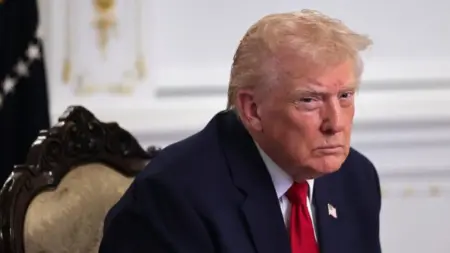A broader look at how American political scandals reveal systemic corruption within government institutions and the need for reform.
How Scandals Expose Systemic Issues
- Scandals often serve as windows into deeper systemic issues within government institutions
- They often reveal individual wrongdoing and structural weaknesses
- Biggest weakness in the US political system is the lack of oversight
Political Corruption: How Scandals Expose Systemic Issues
Political scandals often serve as windows into deeper systemic issues within government institutions, revealing not just individual wrongdoing but also structural weaknesses that enable corruption to thrive. These opportunities have often been exploited by lobby groups and businesses, who have leveraged the need for stock growth, for economic benefit.
From abuses of power to financial misconduct, these controversies highlight vulnerabilities in oversight, accountability, and transparency. While scandals can tarnish individual careers, their broader significance lies in uncovering the systemic flaws that perpetuate corruption and in sparking conversations about the need for reform.
The biggest weakness in the US political system is the lack of oversight, committees and investigations are toothless, beyond a televised showpiece, in holding individuals and lobby groups to account.
The Systemic Nature of Political Corruption
At its core, political corruption arises from the misuse of public office for private gain. Scandals frequently reveal patterns of unethical behavior that extend beyond isolated incidents, reflecting institutional cultures that prioritize self-interest or party loyalty over the public good.

For instance, the Teapot Dome scandal of the 1920s exposed a web of corruption within the federal government, where Secretary of the Interior Albert B. Fall accepted bribes in exchange for leasing public oil reserves to private companies. This scandal highlighted the dangers of unchecked executive power and collusion between government officials and private industry, prompting public demands for stronger oversight mechanisms.
Similarly, the Jack Abramoff lobbying scandal of the early 2000s revealed how lobbyists and politicians exploited campaign finance loopholes to exchange favors, effectively selling access to lawmakers. The scandal demonstrated how systemic issues like lax campaign finance laws and weak ethical standards create an environment ripe for corruption.
The Role of Oversight and Accountability
Scandals often expose a lack of effective oversight, both within government institutions and from external watchdogs. The absence of stringent checks and balances allows corrupt practices to fester unnoticed. For example, the VA (Veterans Affairs) wait-time scandal of 2014 revealed widespread falsification of patient wait-time records within the Department of Veterans Affairs. Investigations uncovered not only individual wrongdoing but also systemic failures in management and accountability that allowed these practices to continue unchecked.
Congressional oversight committees, inspector generals, and independent agencies play critical roles in identifying and addressing such corruption. However, scandals frequently reveal that these mechanisms can be undermined by partisanship, underfunding, or lack of enforcement power. The Iran-Contra affair, for example, illustrated how executive overreach and secrecy could bypass congressional oversight. Despite laws prohibiting funding for Nicaraguan rebels, senior officials within the Reagan administration orchestrated clandestine arms sales to Iran, using the proceeds to support the Contras. This exposed the fragility of institutional safeguards designed to prevent abuses of power.
How Scandals Trigger Reform
While scandals reveal systemic flaws, they also serve as catalysts for reform. Public outrage over corruption often pressures lawmakers to enact changes aimed at increasing transparency and accountability. Following the Watergate scandal, Congress passed a series of reforms, including the Ethics in Government Act and amendments to campaign finance laws, to curb executive overreach and promote transparency in political donations.
Similarly, the Sarbanes-Oxley Act of 2002 emerged in response to the Enron and WorldCom corporate scandals, which implicated politicians who had received campaign contributions from these companies. This legislation aimed to strengthen corporate accountability and improve government oversight of financial practices, highlighting how scandals can extend beyond politics to influence broader regulatory landscapes.
However, reforms inspired by scandals often face resistance. Lobbying interests, partisan divisions, and institutional inertia can dilute the effectiveness of proposed changes, leaving systemic issues only partially addressed.
The Broader Implications of Corruption
Political scandals do more than reveal individual failings—they erode public trust in government institutions. When scandals like the 2008 financial crisis expose collusion between policymakers and corporate elites, they reinforce perceptions of a system rigged in favor of the powerful. This disillusionment can fuel voter apathy, cynicism, and polarization, undermining the legitimacy of democratic institutions.
Moreover, systemic corruption disproportionately impacts marginalized communities. Scandals involving mismanagement of public funds, such as the Flint water crisis, underscore how institutional failures disproportionately harm vulnerable populations. The crisis revealed systemic negligence at both state and federal levels, illustrating how corruption and incompetence exacerbate social inequalities.
The Need for Structural Reform
To address the systemic issues exposed by political scandals, structural reforms must go beyond reactionary measures. Strengthening transparency through robust disclosure requirements, enhancing whistleblower protections, and limiting the influence of money in politics are critical steps toward mitigating corruption.
Technological advancements, such as the use of blockchain for transparent financial transactions or AI to detect fraudulent activities, offer promising tools for combating corruption. As well all have seen with teh corruption of information during the Gaza genocide, AI and tech can all be manipulated and cheated.
Is it all smoke and mirrors?
However, technology alone cannot replace the need for political will and a culture of accountability. Leaders must prioritize institutional integrity over partisan loyalty or personal gain, fostering a system where ethical governance is the norm rather than the exception.
As a final thought, perhaps the reward for corruption is far too great, in American politics, the drive for profit or competence has exceeded the morality of boards to do the right thing over chasing the last ounce of profits to boost financial and stock growth. Is it all smoke and mirrors?
Common FAQs
What was the Watergate scandal in simple terms?

The Watergate Scandal revolved around members of a group associated with Nixon’s 1972 re-election campaign breaking into and planting listening devices in the Democratic National Committee headquarters at the Watergate Office Building in Washington, D.C., on June 17, 1972, and Nixon’s later attempts to hide his administration’s involvement.
What is the Teapot Dome scandal in simple terms?

It centered on Interior Secretary Albert Bacon Fall, who had leased Navy petroleum reserves at Teapot Dome in Wyoming, as well as two locations in California, to private oil companies at low rates without competitive bidding. The leases were the subject of an investigation by Senator Thomas J. Walsh.
What caused the 2008 financial crash?

The catalysts for the GFC were falling US house prices and a rising number of borrowers unable to repay their loans. House prices in the United States peaked around mid 2006, coinciding with a rapidly rising supply of newly built houses in some areas.






